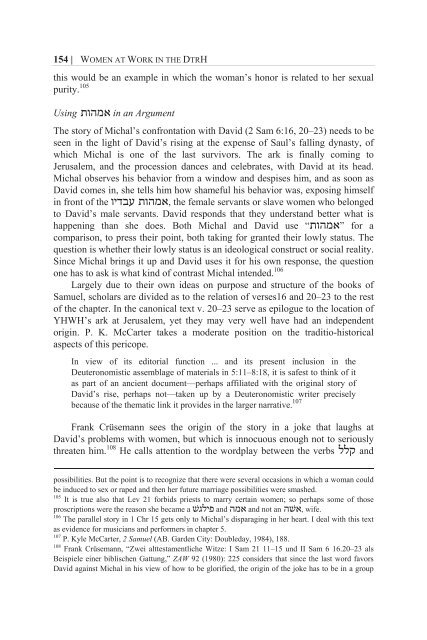Women at Work in the Deuteronomistic History - International Voices ...
Women at Work in the Deuteronomistic History - International Voices ...
Women at Work in the Deuteronomistic History - International Voices ...
You also want an ePaper? Increase the reach of your titles
YUMPU automatically turns print PDFs into web optimized ePapers that Google loves.
154 | WOMEN AT WORK IN THE DTRH<br />
this would be an example <strong>in</strong> which <strong>the</strong> woman’s honor is rel<strong>at</strong>ed to her sexual<br />
purity. 105<br />
Us<strong>in</strong>g תוהמא <strong>in</strong> an Argument<br />
The story of Michal’s confront<strong>at</strong>ion with David (2 Sam 6:16, 20–23) needs to be<br />
seen <strong>in</strong> <strong>the</strong> light of David’s ris<strong>in</strong>g <strong>at</strong> <strong>the</strong> expense of Saul’s fall<strong>in</strong>g dynasty, of<br />
which Michal is one of <strong>the</strong> last survivors. The ark is f<strong>in</strong>ally com<strong>in</strong>g to<br />
Jerusalem, and <strong>the</strong> procession dances and celebr<strong>at</strong>es, with David <strong>at</strong> its head.<br />
Michal observes his behavior from a w<strong>in</strong>dow and despises him, and as soon as<br />
David comes <strong>in</strong>, she tells him how shameful his behavior was, expos<strong>in</strong>g himself<br />
<strong>in</strong> front of <strong>the</strong> וידבע תוהמא, <strong>the</strong> female servants or slave women who belonged<br />
to David’s male servants. David responds th<strong>at</strong> <strong>the</strong>y understand better wh<strong>at</strong> is<br />
happen<strong>in</strong>g than she does. Both Michal and David use “תוהמא” for a<br />
comparison, to press <strong>the</strong>ir po<strong>in</strong>t, both tak<strong>in</strong>g for granted <strong>the</strong>ir lowly st<strong>at</strong>us. The<br />
question is whe<strong>the</strong>r <strong>the</strong>ir lowly st<strong>at</strong>us is an ideological construct or social reality.<br />
S<strong>in</strong>ce Michal br<strong>in</strong>gs it up and David uses it for his own response, <strong>the</strong> question<br />
one has to ask is wh<strong>at</strong> k<strong>in</strong>d of contrast Michal <strong>in</strong>tended. 106<br />
Largely due to <strong>the</strong>ir own ideas on purpose and structure of <strong>the</strong> books of<br />
Samuel, scholars are divided as to <strong>the</strong> rel<strong>at</strong>ion of verses16 and 20–23 to <strong>the</strong> rest<br />
of <strong>the</strong> chapter. In <strong>the</strong> canonical text v. 20–23 serve as epilogue to <strong>the</strong> loc<strong>at</strong>ion of<br />
YHWH’s ark <strong>at</strong> Jerusalem, yet <strong>the</strong>y may very well have had an <strong>in</strong>dependent<br />
orig<strong>in</strong>. P. K. McCarter takes a moder<strong>at</strong>e position on <strong>the</strong> traditio-historical<br />
aspects of this pericope.<br />
In view of its editorial function ... and its present <strong>in</strong>clusion <strong>in</strong> <strong>the</strong><br />
<strong>Deuteronomistic</strong> assemblage of m<strong>at</strong>erials <strong>in</strong> 5:11–8:18, it is safest to th<strong>in</strong>k of it<br />
as part of an ancient document—perhaps affili<strong>at</strong>ed with <strong>the</strong> orig<strong>in</strong>al story of<br />
David’s rise, perhaps not—taken up by a <strong>Deuteronomistic</strong> writer precisely<br />
because of <strong>the</strong> <strong>the</strong>m<strong>at</strong>ic l<strong>in</strong>k it provides <strong>in</strong> <strong>the</strong> larger narr<strong>at</strong>ive. 107<br />
Frank Crüsemann sees <strong>the</strong> orig<strong>in</strong> of <strong>the</strong> story <strong>in</strong> a joke th<strong>at</strong> laughs <strong>at</strong><br />
David’s problems with women, but which is <strong>in</strong>nocuous enough not to seriously<br />
thre<strong>at</strong>en him. 108 He calls <strong>at</strong>tention to <strong>the</strong> wordplay between <strong>the</strong> verbs ללק and<br />
possibilities. But <strong>the</strong> po<strong>in</strong>t is to recognize th<strong>at</strong> <strong>the</strong>re were several occasions <strong>in</strong> which a woman could<br />
be <strong>in</strong>duced to sex or raped and <strong>the</strong>n her future marriage possibilities were smashed.<br />
105 It is true also th<strong>at</strong> Lev 21 forbids priests to marry certa<strong>in</strong> women; so perhaps some of those<br />
proscriptions were <strong>the</strong> reason she became a שׁגליפ and המא and not an השׁא,<br />
wife.<br />
106<br />
The parallel story <strong>in</strong> 1 Chr 15 gets only to Michal’s disparag<strong>in</strong>g <strong>in</strong> her heart. I deal with this text<br />
as evidence for musicians and performers <strong>in</strong> chapter 5.<br />
107 P. Kyle McCarter, 2 Samuel (AB. Garden City: Doubleday, 1984), 188.<br />
108 Frank Crüsemann, “Zwei alttestamentliche Witze: I Sam 21 11–15 und II Sam 6 16.20–23 als<br />
Beispiele e<strong>in</strong>er biblischen G<strong>at</strong>tung,” ZAW 92 (1980): 225 considers th<strong>at</strong> s<strong>in</strong>ce <strong>the</strong> last word favors<br />
David aga<strong>in</strong>st Michal <strong>in</strong> his view of how to be glorified, <strong>the</strong> orig<strong>in</strong> of <strong>the</strong> joke has to be <strong>in</strong> a group




